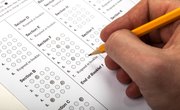Conventional, more traditional, assessment tools evaluate what skills students can perform with success. They are generally knowledge-based, versus hands-on or performance-based. They include traditional types of tests like multiple-choice, short answer essays or constructed responses, and standardized tests such as those districts administer to all students.
Multiple-Choice Tests
Multiple-choice tests are popular tests that require students to recognize correct answers from among several choices, usually three to four with all but one choice wrong. They're easy to score, but not as easy to create because answer choices must carefully balance one correct answer, one close-to-correct answer, with the remaining wrong. Some students consider multiple-choice tests easier than essay tests, and others consider them to be a greater challenge. If a student is fairly good at strategy, he or she is likely to be successful with multiple-choice tests, since points can be scored with a close guess through a process of elimination. But because the answers are somewhat simpler to determine, they cause for a much broader knowledge-base and this makes them more challenging to prepare for. Some students can compensate for a lack of this broader knowledge-base through good test-taking strategy.
Short-Answer Essay Tests
Educators design short-answer essay tests to evaluate what can't be articulated through multiple-choice questions. The tests generally require a deeper, more detailed analysis of content that requires higher-order thinking. For this reason, many students find essay responses to be more of a challenge. Question prompts are used to elicit students responses, and can often involve application of complicated concepts, synthesis and problem-solving through the making of comparisons, identification of similarities and differences, and cause and effect relationships. Questions typically use language like "explain," "how would" "describe" and "assess."
Constructed-Response Tests
Constructed-response tests require short answer or fill-in-the-blank questions, and require a blend of factual knowledge and higher-order reasoning. Students place their own information in missing spaces rather than from among several pre-prepared choices. They're much easier to create than multiple choice, and can retain control over guessing. For this reason they're more difficult to score, and usually require manual scoring with each response read and evaluated on its merits. When used as part of a comprehensive standardized test, they tend not to be weighted as heavily as other questions for ease of scoring.
Standardized Tests
Schools use standardized tests widely on a national level, and they are part of every school district's accountability design. Many are considered "high stakes" because they're taken by large populations of students, and if they do not perform well, districts could lose valuable federal and state funding. Standardized tests need to be easily scored for this reason, and are therefore designed using a typical combination of multiple-choice, short answer, document-based questions and constructed responses.
Related Articles
References
Writer Bio
Susan Ruckdeschel began writing in 1989 as a guest columnist for the "Rochester Democrat and Chronicle." Her work continues to blossom, with the recent publication of a handbook for teachers and numerous other books soon to be released. Ruckdeschel has a Master of Science in education from Nazareth College and is completing her Doctor of Philosophy in educational leadership.











